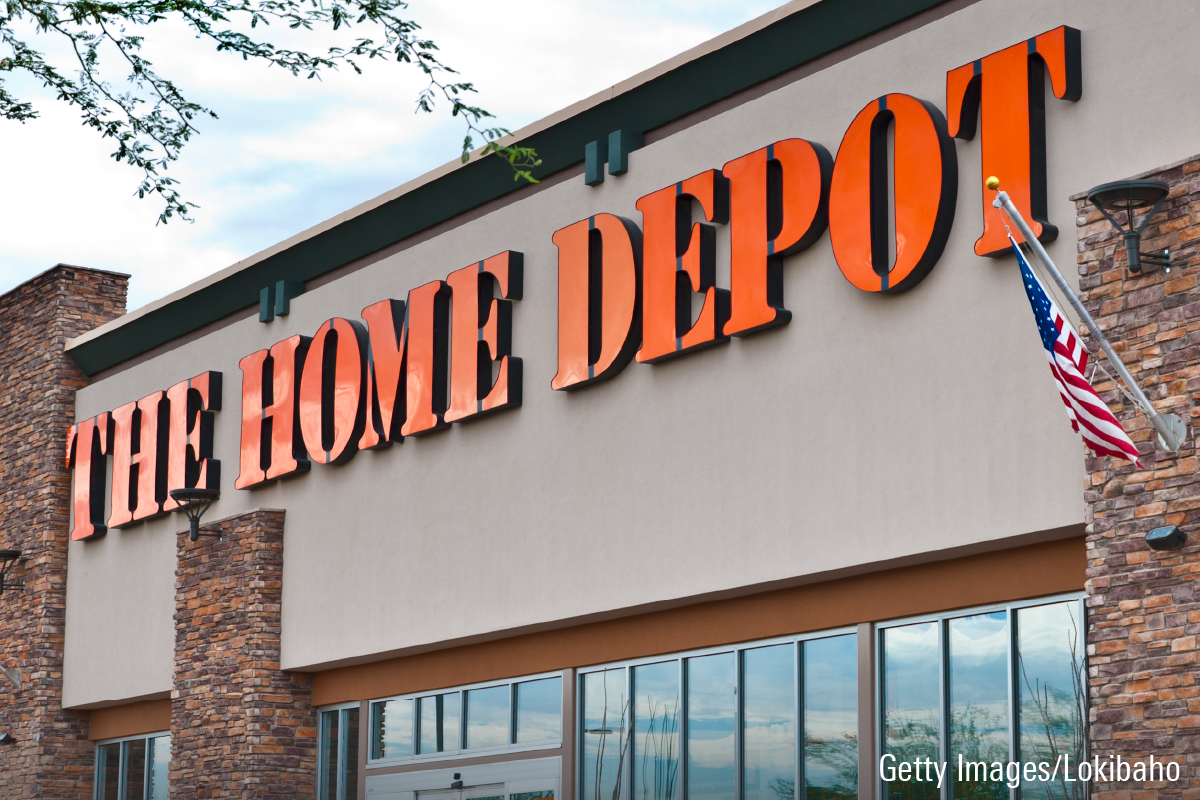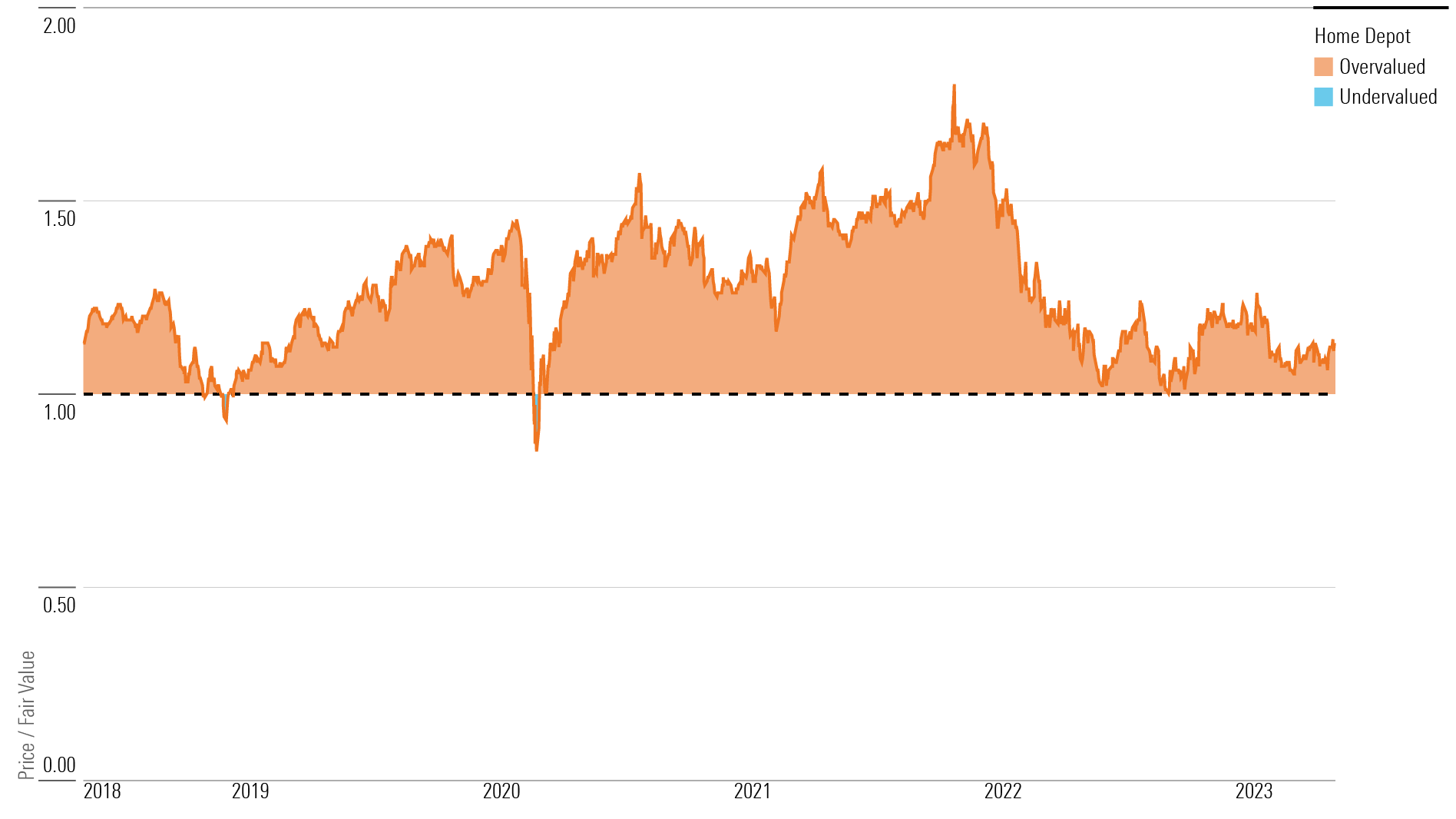Is Home Depot Stock a Buy, a Sell, or Fairly Valued After Earnings?
With softer consumer demand and sales, here’s what we think of Home Depot stock.

Home Depot HD released its fiscal first-quarter earnings report on May 16, 2023. Here’s Morningstar’s take on what to think of Home Depot’s earnings and stock.
Home Depot Stock at A Glance
- Fair Value Estimate: $259
- Morningstar Rating: 2 stars
- Morningstar Uncertainty Rating: Medium
- Morningstar Economic Moat Rating: Wide
What We Thought of Home Depot’s 1Q Earnings
Weather and consumer concerns weighed on Home Depot’s results more than we had anticipated. While we expected a decline in same-store sales of 1%, the metric contracted 4.5% as consumers pulled back on high-priced home improvement projects. This led to a lower 2023 outlook from Home Depot, implying some lost sales may not be recovered or that soft consumer behavior could persist. Either way, our 2023 reduction in sales and earnings per share reduced intrinsic value by $8. Our fair value estimate for Home Depot stock now stands at $259.
Fundamentally, our hypothesis on Home Depot stands unchanged. We believe long term the business should be able to generate robust free cash flow, allowing for the ongoing payment of dividends and repurchases, accruing benefits to shareholders. However, we contend that Home Depot is operating near-peak operating margin levels, and with little expansion opportunity in the metric the stock remains modestly overvalued.
Home Depot Stock Price

Fair Value Estimate for Home Depot Stock
At a 2-star rating, Home Depot stock is overvalued compared with our fair value estimate.
We lowered our fair value estimate for Home Depot stock to $259 per share from $267 to account for slowing top-line momentum and resulting sales deleverage. Nonetheless, Home Depot continues to invest in merchandising, supply chain, and employees, which we contend should support its brand intangible asset. For 2023, we now expect $153 billion in sales, a 14.3% operating margin, and $15.23 in EPS.
Given the maturity of the domestic home improvement industry, we expect demand to largely depend on changes in the real estate market, driven by prices, interest rates, turnover, and lending standards. Longer term, we forecast gross margins to expand modestly over the next decade (by 10 basis points from 2022 levels, to 33.6%) while the SG&A expense ratio remains flattish (around 17%) as the firm capitalizes on its scale and supply chain improvement initiatives while investing to protect its market leadership perspective. This leads to a terminal operating margin of 15.5%, higher than the 15.3% peak achieved in 2022.
Read more about Home Depot’s fair value estimate.
Microsoft Price/Fair Value Chart

Economic Moat Rating
We assign Home Depot a wide Morningstar Economic Moat Rating. As the largest global home improvement retailer, the company possesses a competitive edge owing to its brand intangible asset and cost advantage. For one thing, we believe its extensive product offerings and services have fostered brand loyalty. To continue to engage its consumers and keep up with changing customer demand (for localization and personalization, for instance), Home Depot leverages consumer data, collaborates with suppliers, and conducts periodic merchandising resets to refine its assortments. Additionally, Home Depot’s value-added services (including tools and trucks rental, installation, and remodeling) allow its wide range of customers to easily undertake their projects, which in our view further elevates the customer experience. An important aspect of Home Depot’s brand intangible asset lies in its omnichannel capabilities, which we think protect the firm’s competitive position and prevent customer attrition by enabling them to buy what they want and how they want it.
In our opinion, it would be difficult for another retailer to enter the market and threaten Home Depot’s position, as smaller retailers would have a hard time building vendor relationships strong enough to undermine Home Depot’s pricing prowess.
Read more about Home Depot’s moat rating.
Risk and Uncertainty
We give the company a Medium Uncertainty Rating owing to its strong brand recognition, which has helped stabilize sales through the cycle. Thanks to the maintenance, repair, and operations business (Interline Brands and HD Supply), pro revenue could be less cyclical, as the maintenance side of the business can prove more consistent.
Although new competitors could set up shop on Home Depot’s turf, we think new players would be hard-pressed to offer similar product prices, as they likely wouldn’t have vendor relationships of the same magnitude.
In our opinion, Home Depot has minimal environmental, social, and governance risk.
We believe the biggest risk is a slowdown in the real estate market, signaled by increased home inventories for sale, slower price growth, or higher mortgage rates (up about 110 basis points in the last 12 months).
Read more about Home Depot’s risk and uncertainty.
HD Stock Bulls Say
- Home Depot’s continued investments in supply chain and merchandising should improve productivity and support its market leadership position in the home improvement market.
- The company has returned $70 billion to its shareholders through dividends and share buybacks over the past five years, above 20% of its market cap. In our outlook, we forecast Home Depot returning another $80 billion to shareholders over the next five years.
- The addressable MRO market is around $100 billion, and Interline and HD Supply make up a low-double-digit share, leaving meaningful upside up for grabs.
HD Stock Bears Say
- Weak consumer spending, higher interest rates, or an economic downturn could hinder sales for home improvement projects and affect Home Depot’s growth.
- IT and supply chain improvement gains could prove more challenging to achieve, as simpler efforts have already borne fruit. Further productivity efforts could face some implementation risks, creating inconsistent profitability.
- As home improvement demand normalizes, consumers could continue to shift discretionary spending away from home improvement and back into other discretionary categories like leisure and restaurants.
This article was compiled by Muskaan Hemrajani.
Get access to full Morningstar stock analyst reports, along with data and tools to manage your portfolio through Morningstar Investor. Learn more and start a seven-day free trial today.
The author or authors do not own shares in any securities mentioned in this article. Find out about Morningstar’s editorial policies.

/s3.amazonaws.com/arc-authors/morningstar/3559e02b-f74d-4a72-a821-b50f61ba05e9.jpg)
/cloudfront-us-east-1.images.arcpublishing.com/morningstar/T5MECJUE65CADONYJ7GARN2A3E.jpeg)
/cloudfront-us-east-1.images.arcpublishing.com/morningstar/VUWQI723Q5E43P5QRTRHGLJ7TI.png)
/d10o6nnig0wrdw.cloudfront.net/04-22-2024/t_ffc6e675543a4913a5312be02f5c571a_name_file_960x540_1600_v4_.jpg)
:quality(80)/s3.amazonaws.com/arc-authors/morningstar/3559e02b-f74d-4a72-a821-b50f61ba05e9.jpg)